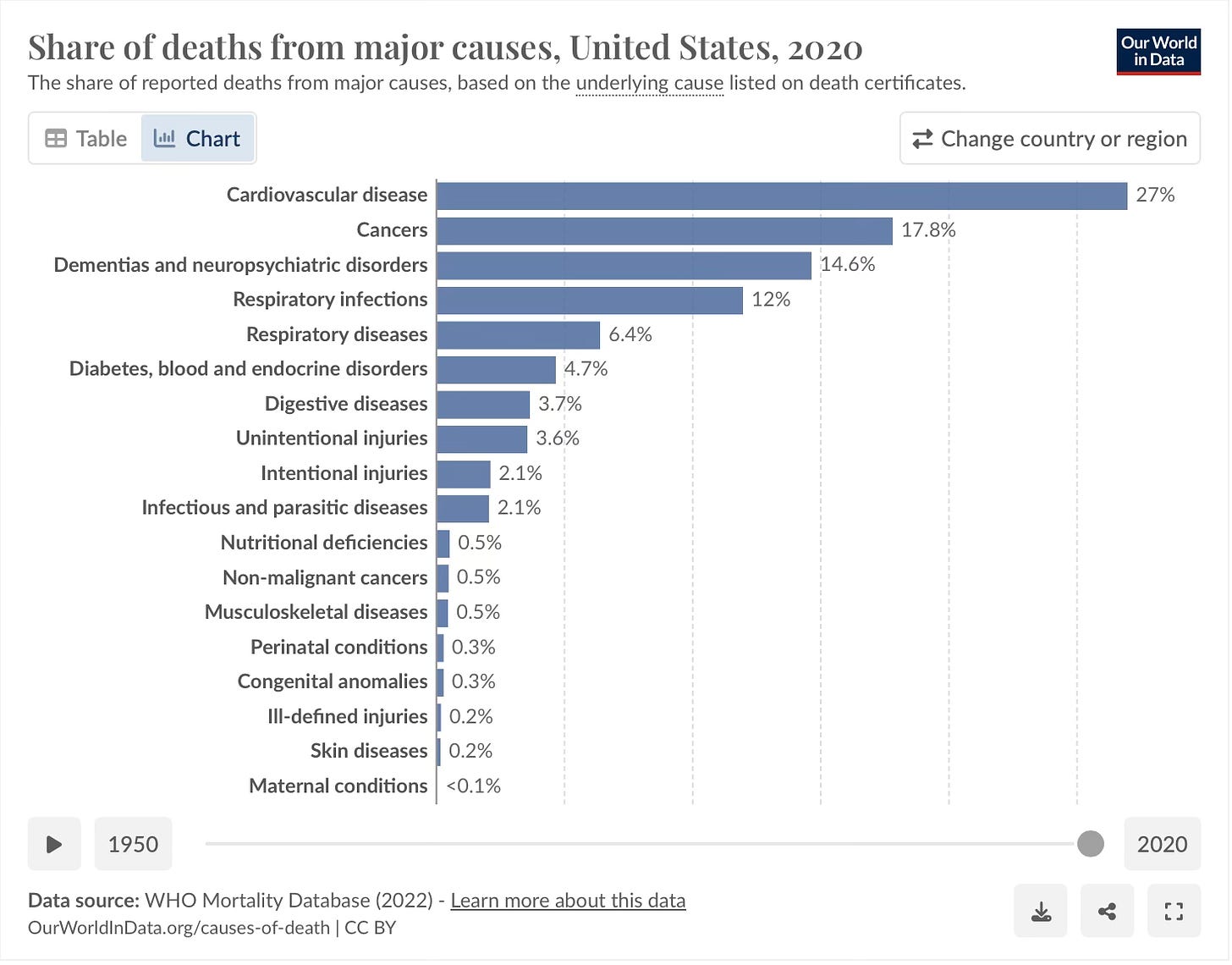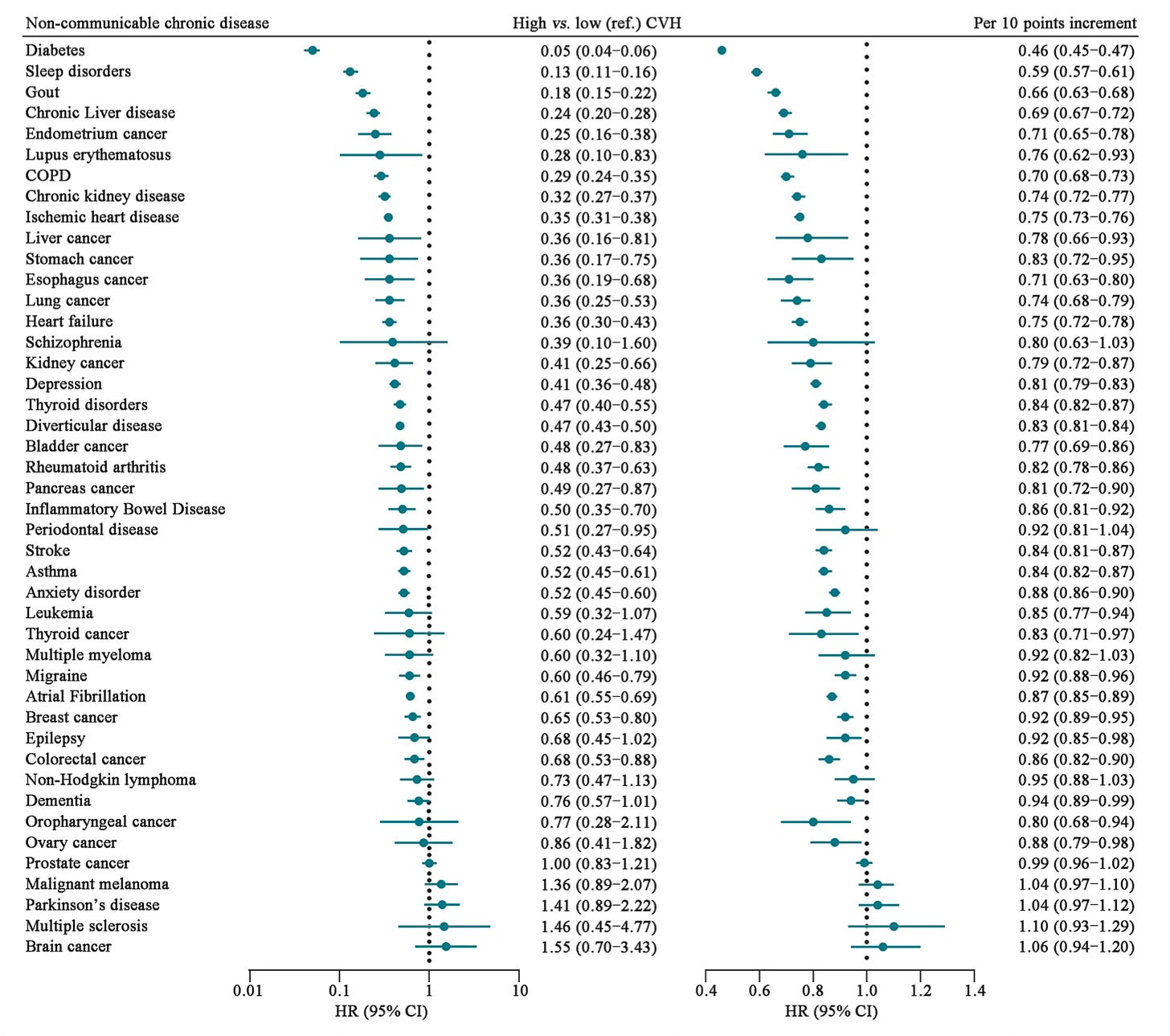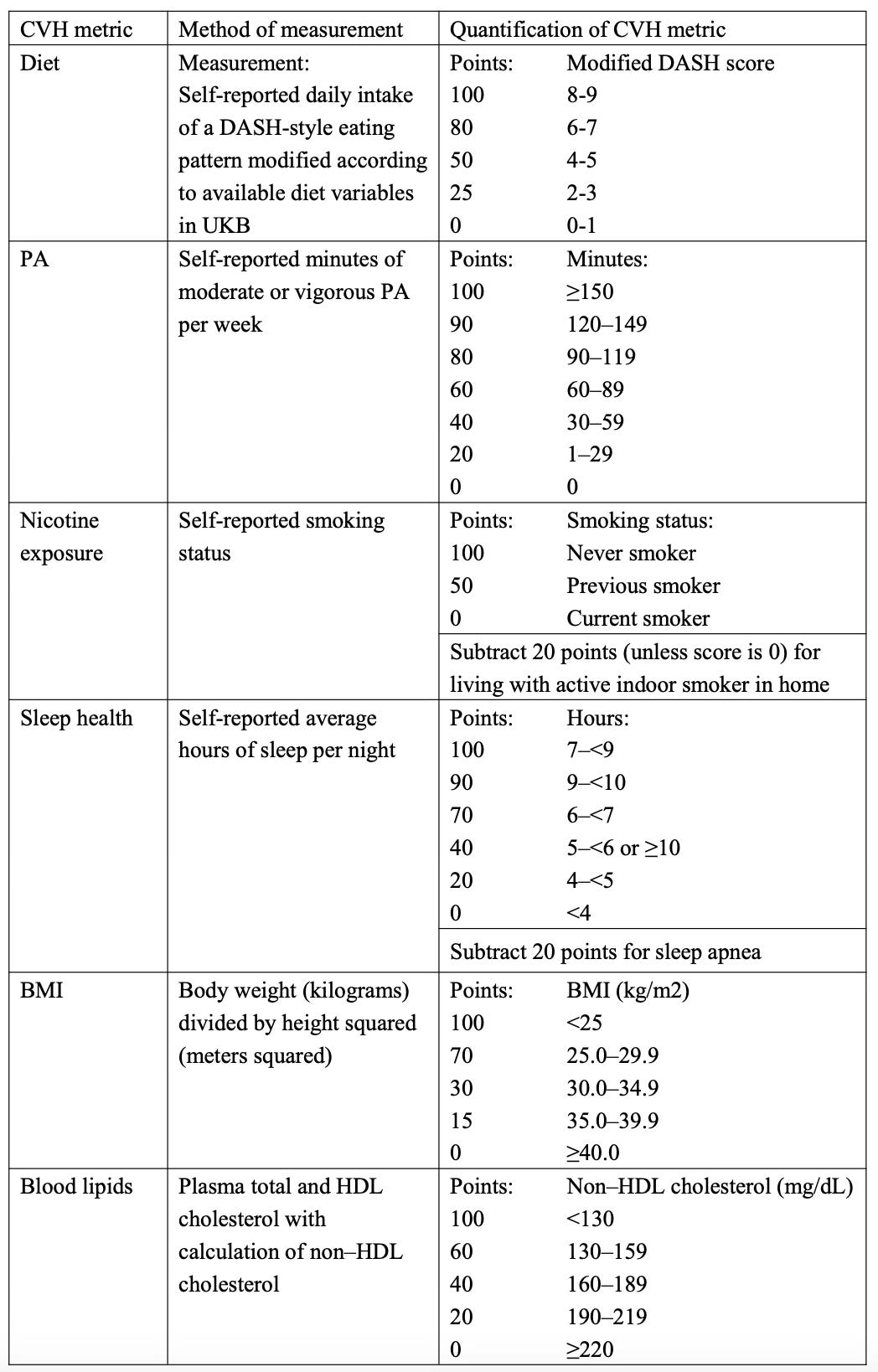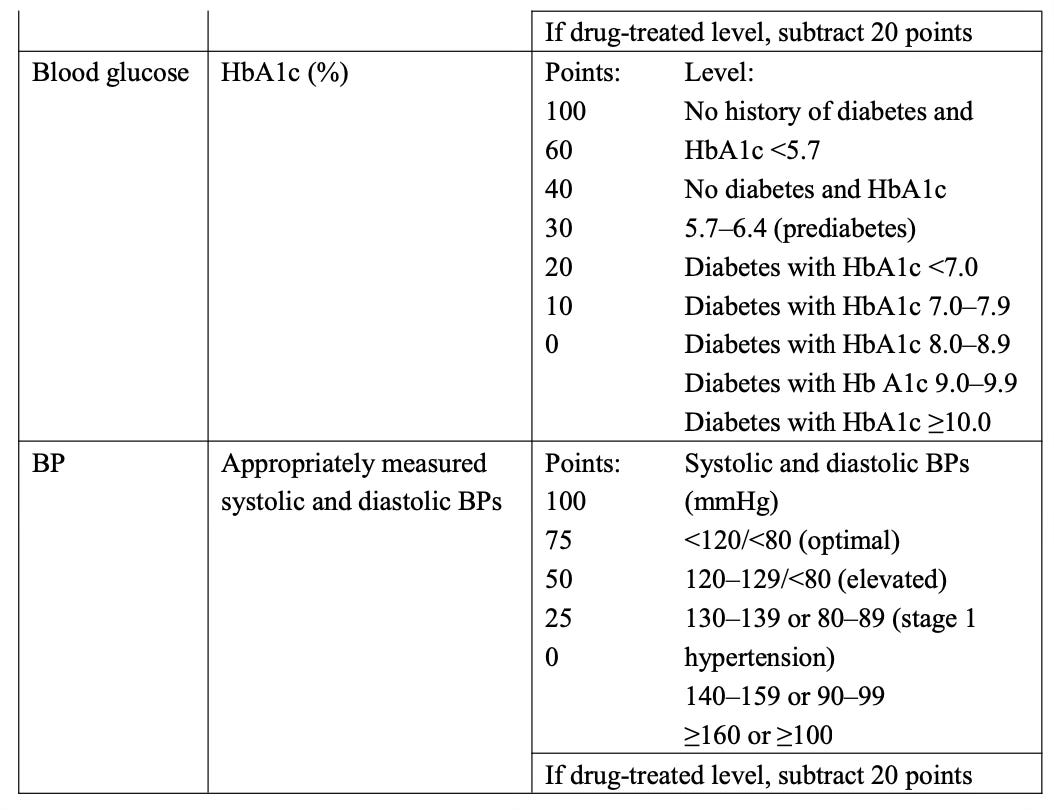Decoding Longevity. How To Not Die.... Young

Life is a game of odds.
We would all love to have guarantees that we will not get sick, that those we love will not die, and that by simply doing ‘all the right things’, we will avoid any health issues.
But that’s just not how life works.
But you can tilt the odds in our favour.
To an enormous degree.
Firstly, you have to know your foe.
If you were living in Central Europe in the 1500s, your foe would have been infectious disease.
If you wanted to live a longer life, the main priority would have been to do everything necessary to avoid exposure to a pathogen that would have killed you, given the absence of anything resembling ‘healthcare’ at the time.
Today, your foe is different.
Today’s foes are not communicable pathogens but ‘Non Communicable Diseases’ NCDs.
In most developed countries as of today, NCDs account for 89% of all deaths.

Even within the class of NCDs, we have to think about probabilities.
The leading causes of death are clear.
Cardiovascular disease, cancer and dementia account for 60% of all deaths in the US.
These are NCD’s.
Sure, you could die from an ‘ill-defined injury’, whatever that is, but keeping your focus on the first three will give you the biggest bang for buck.

Can these conditions be avoided?
The simple answer is yes.
And getting your lifestyle factors in order is key.
But ‘Lifestyle’ always seems like such a nebulous term, so let’s add some precision.
The Life’s Essential 8 is a set of factors we can use to characterise and quantify a healthy lifestyle.
The 8 factors include:
-
Nutrition - Mediterranean Eating Pattern Score
-
Physical Activity - >150 mins Mod-Vigourous Weekly Activity = Ideal
-
Smoking Status - Never = Ideal
-
Sleep - >7 hours per night = Ideal
-
BMI - <25 = Ideal
-
Non-HDL Cholesterol - <3.36mmol (130 mg/dl ) = Ideal
-
Blood Glucose - HBA1c < 39 = Ideal
-
Blood Pressure - <120/<80 = Ideal
Each of these is evaluated and then combined into a score ranging from 0 to 100.
-
Low = 0 - 49
-
Moderate = 50 - 79
-
High = 80 - 100
What Happens To NCD Risk When You Get These Right?
The answer is that risk plummets.
Probably far more than you think.
Yes, many external factors impact these factors, but ultimately, you have significant control over all of these.
“Maybe not your fault, but definitely your problem.”
And addressing that problem pays huge returns.
Let’s look at what happens to NCD risk when these risk factors are optimised.
UK Biobank
A study including 170,726 participants of the UK Biobank gives us a lot of insight here.
This group’s lifestyle was assessed using the above criteria and tracked for ten years to see how this influenced their risk of non-communicable diseases1.
The relationship was clear.
The higher your lifestyle score, the lower the probability of a host of diseases.
Let’s start with Cancer.
Compared to those who had ‘Low’ lifestyle scores, those with ‘Ideal’ scores were 27% less likely to be diagnosed with cancer in the next ten years.
For every 10-point increase in their lifestyle score, the risk of cancer decreased by 8%, but this is not an ‘All Or Nothing’ affair.
-
Colorectal Cancer 32% Less
-
Breast Cancer 45% Less
-
Pancreatic Cancer 51% Less
-
Kidney Cancer 59% Less
-
Lung Cancer 64% Less
-
Liver Cancer 64% Less
When it comes to cancer, sheer bad luck and randomness play a huge role.
Some people do all the right things and still are diagnosed with cancer.
But getting lifestyle right can seriously help tilt the odds in the right direction.
Mental & Behavioural Disorders
The authors chose this classification, not me, but we have to work with what we have.
For those in the ‘Ideal’ category, they were 51% less likely to have either dementia or depression.
Interestingly, however, the effect on dementia alone was not significant, and the majority of the reduction was driven by a reduction in depression.
This is certainly at odds with multiple previous studies which have demonstrated that optimal lifestyle factors have reduced the incidence of dementia, something I have written about extensively here.
Cardiovascular Disease
Those in the ‘Ideal’ category were 55% less likely to develop diseases of the circulatory system, including:
-
Heart Disease
-
Stroke
-
Heart Failure
-
Atrial Fibrillation
For each 10-point increment in lifestyle score, there was a proportionate 20% reduction in these conditions combined.
Metabolic Disorders
This is where things get very interesting.
As I have written about before, the risk of all three conditions mentioned above, which are leading causes of death, are driven by poor metabolic health ranging from insulin resistance to the more extreme phenotype, type 2 diabetes.
Those in the ‘Ideal’ lifestyle category had 84% fewer metabolic diseases.
However, the way they classified this was unusual as they put both type 2 diabetes and thyroid disorders together.
Let’s look at them separately.
Thyroid disorders were about 53% less in the ideal group, but the real impact was on type 2 diabetes.
Compared to the ' Low ' category, those in the ‘Ideal’ category of lifestyle had a whopping 95% less diabetes.
There is no doubt that confounders are at play here and indeed for all the above conditions mentioned, but I believe we can say with very high confidence that excellent lifestyle factors can massively reduce the risk of diabetes.
And less diabetes means less of a driver of the three main leading causes of death - cardiovascular disease, cancer and dementia.
Remember, this was only a 10-year follow-up.
Longer-term follow-up with continued adherence to good lifestyle principles is likely to pay dividends for decades.
Let’s look at all these conditions together when you compare the ‘Ideal’ versus the ‘Low’ score groups.

The differences are enormous, and the 95% reduction in diabetes makes the other conditions, which are ‘only’ reduced by 50%, look less impressive.
But do not be deceived; the impact across the board here is substantial.
Optimal lifestyle factors are not a panacea for everything in life.
In this study, Parkinson’s, Brain Cancers, Multiple Sclerosis and a variety of other conditions were not less in the ideal group.
There are no guarantees.
But there are odds we can tilt.
Achieving all the metrics of an ideal healthy lifestyle is hard.
No doubt.
But ask yourself if these odds are worth that investment.
I certainly think they are.
Even if you cut the odds in half, it is still a good bet.
So, ask yourself honestly where YOU are on this scale.
And recognise that if you are not in the ‘Ideal’ category, you can still make changes to make a difference.
To give you a sense of where you fall, the exact measures used in the trial are listed below.
Onwards and upwards.
Keep the odds on your side.
Let randomness take the rest.


Life's Essential 8 and risk of non-communicable chronic diseases: Outcome-wide analyses. Chinese Medical Journal ():10.1097/CM9.0000000000002830, October 10, 2023.




